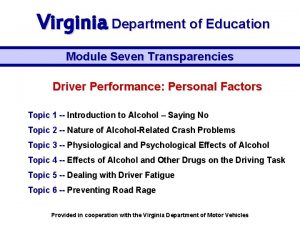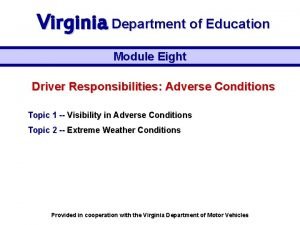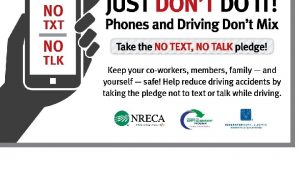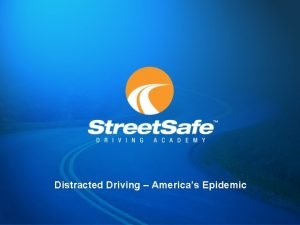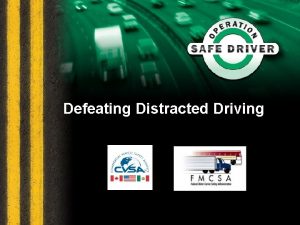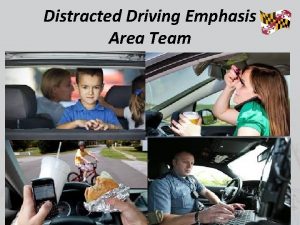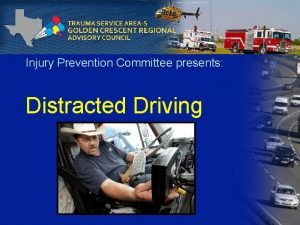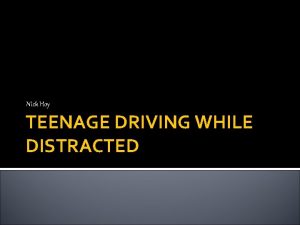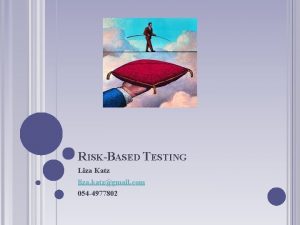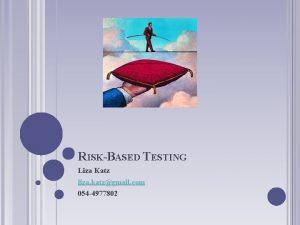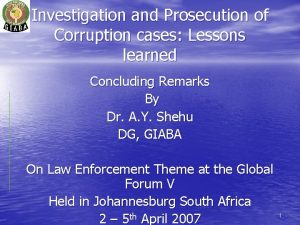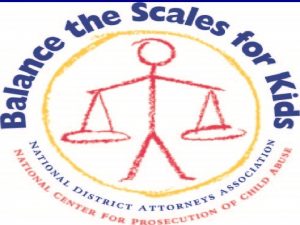Investigation and Prosecution of DISTRACTED DRIVING Cases Liza














- Slides: 14

Investigation and Prosecution of DISTRACTED DRIVING Cases Liza Lemaster-Sandbank Sr. Highway Safety Specialist, NHTSA Stephanie Fitzgerald Senior Asst. Commonwealth’s Attorney Spotsylvania County, VA

Investigation & Prosecution of Distracted Driving Cases • Chapter 1 - Why Distraction Is a Problem • Chapter 2 - Types of Distraction • Chapter 3 - Trends in Enforcement • Chapter 4 - Investigating and Charging Distracted Driving Cases • Chapter 5 - Proving the Distracted Driving Case

Chapter 1 - Why Distraction Is a Problem q In 2016, in the U. S. , there were: • 396 million wireless subscriptions (1. 22 person) • 309. 8 million smart phones & tablets • 5. 3 billion text messages per day (CTIA, 2017) q In 2016, distraction-affected crashes resulted in 3, 450 fatalities (NHTSA, April 2018), q In 2015, an estimated 391, 000 people were injured in distractionaffected crashes,

What’s the problem? q Overall, 10% of fatal crashes, 16% of injury crashes, & 14% of all motor vehicle traffic crashes are distracted-affected, q Drivers observed text-messaging or manipu lating handheld devices (NOPUS, 2017): • 2. 1% in 2016 • 4. 5% of drivers aged 16 -24 in 2016 q Challenge: Data Limitations

Demographics & Characteristics of Distracted Drivers • An estimated 481, 000 passenger vehicles driven by people using handheld cell phones at a typical daylight moment in 2016. (National Occupant Protection Use Study – NOPUS) • The 2016 NOPUS found that handheld cell phone use continued to be higher among female drivers than male drivers. • Handheld cell phone use continues to be highest among 16 - to 24 -year-old drivers, and lowest among drivers 70 and older. (2015 NOPUS)

The extent of mobile phone use according to CTIA: • According CTIA Everything Wireless, in 2016 almost every person in America has a mobile phone. • There are now more wireless devices than Americans, with about 1. 2 devices for every person in the country. • In 2016, 1. 939 trillion text messages were sent in the US. • Ninety percent of consumers say they read a message within minutes of receipt.

2015 Nati on al Su rv ey o n Di str acted Driving Attit udes and Behaviors Survey Conclusions • Distraction is not isolated to young drivers, • Respondents perceived that texting/emailing is more dangerous than talking on the phone, • Drivers frequently perform tasks they view as unsafe when they are passengers, • Well over 50% of drivers believe that there is no difference in their driving talking or using phone/apps, • Realizing distraction is a problem is not enough.

Chapter Two - Types of Driver Distraction External and Internal Distractions Visual Manual Cognitive NHTSA broadly defines driver distraction as anything that can take visual, manual or cognitive resources away from the driving task.

Chapter Three – Trends in Enforcement • • Jurisdictionally specific laws Federal law (model language) Distracted Driving Indicators Countermeasures and Strategies Law Enforcement Training HVE Patrol Strategies (Highway, Secondary roads, Paired, Motorcycle) Documentation

Resources • Distracted Driving Training Course: Virtual LIVE (On-line) course available through TSI. “The goal of this training is to enhance your knowledge and understanding of distracted driving by providing resources and strategies to effectively enforce State and local laws, which restrict and prohibit certain behaviors with the intent of reducing distraction -affected crashes. ”

Investigation and Prosecution of Distracted Driving Cases This monograph provides guidance and training materials to assist State and local attorneys, and other members of the judiciary, in prosecuting distracted driving cases that involve a serious injury or fatality. (https: //www. nhtsa. gov/sites/nhtsa. dot. gov/files/ documents/812407 -distracteddrivingreport. pdf)

Chapter Four—Investigating and Charging Distracted Driving Cases • • • Collection of Evidence Physical Evidence Event Data Recorders Non-Electric Evidence Absence of Evidence Seizing Physical Evidence Preserving Physical Evidence & Electronic Data Testimonial Evidence, Witnesses Charging Decisions

Chapter Five—Proving the Distracted Driving Case • Trial Witnesses – Mobile device forensic examiner/analyst who completed data extraction and interpretation – Cell phone company records representative and/or records custodian – Research scientist/expert on distractions related to driving – Crash reconstruction expert – Crash team investigator – Road and/or mechanical engineer – Auto manufacturer • Trial Exhibits

THANK YOU LIZA LEMASTER-SANDBANK 202 -366 -4292 liza. lemaster@dot. gov STEPHANIE FITZGERALD 540 -507 -7650 sfitzgerald@spotsylvania. va. us 14
